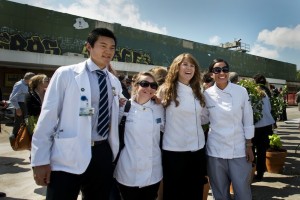
Leah Sarris, program director of Tulane’s Goldring Center for Culinary Medicine (second from right) celebrates groundbreaking for a new kitchen with a Tulane med student and two Johnson & Wales culinary nutrition students.
By Laurie Wiegler
While the general population is gradually learning that eating well can stave off some of society’s worst diseases such as diabetes and obesity, the medical community has been even slower to follow suit. Remarkably, medical school programs, at least traditionally, do not require taking nutrition and medical doctors can actually graduate being clueless on the concept of using food to cure what ails us.
All of that could change thanks to some forward-thinking individuals at Tulane University’s Goldring Center for Culinary Medicine in New Orleans and at Rhode Island’s Johnson & Wales University.
A dose of good medicine
Drawing from culinary expertise from partner Johnson & Wales of Rhode Island, Tulane is revolutionizing how doctors look at food and nutrition — which will serve them well as they become tomorrow’s pediatricians, cardiac specialists and oncologists. J&W, in turn, brings the med students to its campus to matriculate amongst the chefs in approximately one-month rotations. The med students work for about two months in the Tulane kitchen.
These elective sessions are credited at both institutions, and since 2012 have married the expertise of both doctors and chefs. It’s a twist on the standard college cooking class, and addresses the question: ‘What if one’s doctor could advise us on which foods were best for our health?’
How it All Came About
WACS Global Master Chef Karl Guggenmos, J&W’s university dean of culinary education, says that while the idea for the food-as-medicine concept generated at Tulane, the timing was synchronistic.
“The idea we had contemplated [regarding] our nutrition program, [was] what is the next level? How can we move it up a notch and make sure it moves up to a higher level?”
It’s a twist on the standard college cooking class, and addresses the question: ‘What if one’s doctor could advise us on which foods were best for our health?’
Meanwhile, Tulane’s Dr. Tim Harlan, an internist also called “Dr. Gourmet” was a chef before entering medical school. He was thinking along similar lines as Guggenmos when he approached J&W in early 2012. By March of that year, students were coming to Tulane to be taught by the new program director, 2005 J&W alum Leah Sarris.
“Our first students from J&W came almost at the same time that Leah came,” says Harlan. “Our med students started going to J&W in January of 2013.”
Guggenmos and staff were excited by the possibilities. He says, “We had not talked before and then Dr. Harlan called me and said their goal was to teach physicians of the future how to cook; [these would be] evidence-based programs that relate food and medicine and how it impacts health – cardiac, diabetes, and so forth.”
Guggenmos pointed out that “a lot of research has already been done in terms of how food affects the body” and this new team would not only exploit the knowledge by teaching it to their students, but take it to under-served communities struggling with high blood pressure, obesity, diabetes and nutritional challenges.
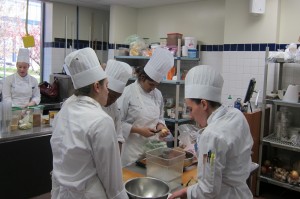
Dr. Harlan is a bit reticent to join the “eat this, not that” bandwagon and stresses it’s more about incorporating the recommended amounts of protein, carbohydrates and nutrients into a relatable message. “How do you translate that basic nutrition-type knowledge into …[a] meaningful way for patients to eat?”
It’s a recipe that works for not only Tulane, but according to Harlan, for UT Southwestern and North Texas Univ., to whom the curriculum has been licensed; and, he says, Goldring is waiting on a signature from a dean at a west coast medical school.
Such popularity doesn’t surprise the center’s R&D director, Louisiana native Dominique Monlezun, a triple MD/PhD/MPH candidate at Tulane.
“The crux of Golding’s mission is the patient-physician relationship…[that] is the starting point, getting back to the foundation of medicine. The Hippocratic Oath assumes medicine is in companionship with your patient,” Monlezun says.
At Goldring, the doctors of the future are ensuring they become as companionable as possible by instructing patients not only on where to cut fat, salt, sugars and so forth, but by recommending healthier options such as whole-wheat pasta dishes and veggie-rich meals. (See recipes)
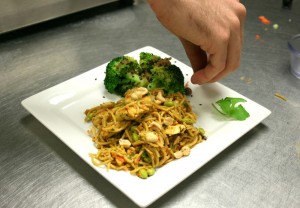
Asian Peanut Noodle Salad is one of the many recipes med students are taught to prepare so that they can teach their patients.
Chef Leah’s Kitchen
Goldring’s Sarris says that, “The evidence is clear: we have an epidemic here [in the South] of obesity and heart disease. We’re needed here, we’re needed here the most.”
She points out that the Deep South contains many of the nation’s poorest areas, too, and “there is a high correlation between income and eating habits and even education levels. So we have our work cut out for us.”
Sarris is intent on her mission yet has the kind of youthful vibe that attracts and entertains, whether that means understanding why wheat pasta is better than white, or how a mushroom can provide a meaty taste. Her conversational manner is breezy though her mind is as sharp as her knife.
She shared secrets for healthier meals, tips that make their way into the culinary kitchen at Tulane. In May, a new facility off campus will be complete and Goldring can move out of the medical school’s kitchen. A 4,600-square-foot center, it will be built as part of the “ReFresh Project”, a redevelopment of a former grocery store on Broad and Bienville streets that will include a Whole Foods.
But Sarris is more about the contents of her healthy message than concerned about fancy kitchens and real estate. She wants students to know her tricks, such as how taking out half the meat in spaghetti sauce saves money, yes, because “now you have that pound of beef for two meals,” but more importantly, it’s also healthier.
She shows students a way to keep some of the beef and save money, but gradually demonstrates why the meat’s unnecessary. She not only incorporates mushrooms for beefy texture and vitamins, but flavor; then adds more veggies and herbs to the sauce.
“We measure our salt, don’t just add it blindly. We use wheat pasta, and they [the students] taste it, and then [after an initial introduction to a white spaghetti-with-meat recipe], after one time I say, ‘Okay, this is what we’re using.’”
Students then start incorporating lentils into the spaghetti sauce, then a third version is created that combines lentils and beef. “People love the lentils,” she gushes. “They tell me all the time they make this dish at home.”
Yet, of course, spaghetti is just the starting-off point for these med students hungry for more, whether that means mastering a mean Honey Mustard Pork Tenderloin, which second-year med student Dennis Ren calls “a real treat” or making Sarris’ killer fish tacos with corn relish.
Sarris’ method of making sessions not only informative but fun is no doubt the draw for not only med students like Ren, but the dietetic interns and nutritional students from J&W.
Since the arrangement with J&W began two years ago, interns from the culinary school have trickled in, growing from about one at a time to about four students now. They stay for a couple months at a time at Tulane; med students visit Rhode Island for about a month. Sarris says, “The students going to J&W, going forward, should have done the elective with me their first year of medical school.” They will have learned basic knife skills, as well as culinary and nutrition knowledge before they go north, she says.
While it all sounds like a perfect mix, chefs and docs, sometimes the couplings are a little, well, daunting.
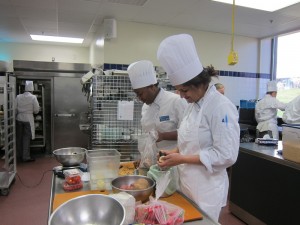
Chloe Marshall, who is completing her culinary education at J&W this year and did the rotation at Tulane in 2012, says her challenge was overcoming the intimidation of working with med students. “Not that they were intentionally intimidating,” she says quickly. “It was just totally different for me and exciting [to work alongside them].”
For the medical students, intimidation came in a different form.
Ren said, “I don’t think I would call any experience I’ve had with the teaching kitchen ‘challenging’ because even the parts I initially struggled with a little bit were really fun. An example that comes to mind is learning how to set up a cooking station (utilizing mise en place) and properly use a knife to dice/julienne/mince, etcetera.”
He says after that first session, he realized how much he’d been doing wrong “or at least inefficiently.” Since then, his own cooking has become “way speedier and more efficient.”
Recipe for Healthy Communities
Monlezun says there are four tiers of study within Goldring, and these are: 1) as 24 hours of an elective for 1st and 2nd year med students; 2) for third-year med students who’ve taken interdisciplinary seminaries; 3) for fourth-year medical students, who go to J&W and then to Rhode Island Hospital because “we want to make sure they translate what they do to patient outcomes”; and finally, level four, which is where he believes the “kicker” is: service learning. Med students from first through fourth year go into communities and lead classes.
Back in the kitchen, Sarris leads six two-hour community classes as part of the program for both culinary and med students, where “we’re teaching people a lot of the same thing we teach students, like meal planning.”
She says it’s very hands-on, with medical students working alongside community members at the Tulane facility, as well as going out into the community of New Orleans.
“It’s mostly medical students and a few culinary students – me and them floating around,” she says of the onsite work.About four community members come to campus per term, each paired with a med student, dietetic intern or culinary nutritionist student from J&W.
Dr. Harlan visits the kitchen regularly and Chef Guggenmos says he comes “about every other month,” but Sarris doesn’t need a lot of oversight. She just delights in the joy of not only cooking, but making a difference – with a little help from a familiar source.
“The J&W [students visiting] is largely the culinary support I need,” she says.
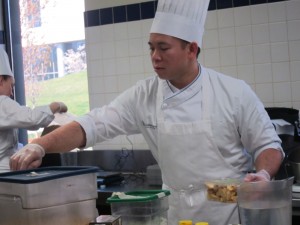
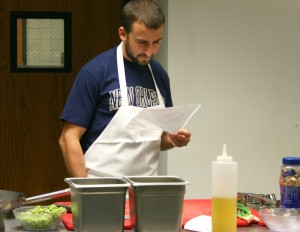
Leave a Reply